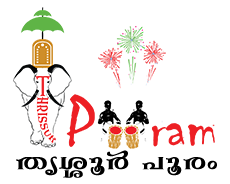Latest News
Vadakkumnathan Temple - An Artistic Marvel
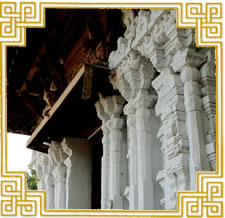
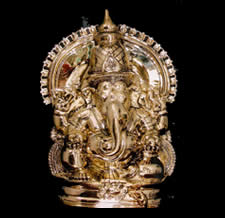
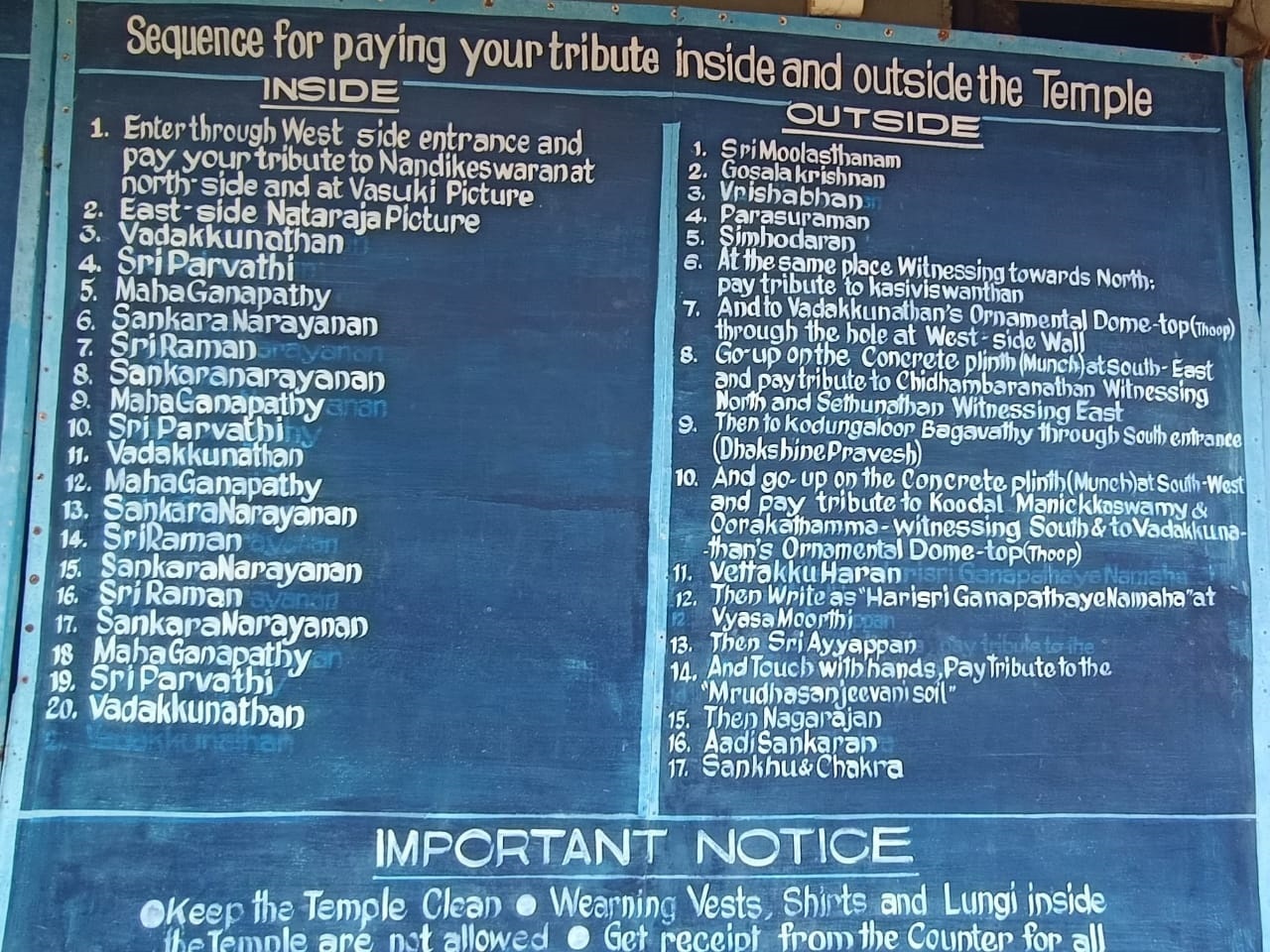
One of the largest temple complexes in South India is a classical example of rich Kerala temple Architecture. The main temple complex is spread over nine acres on a small hillock encircled by 64 acre Thekkinkadu maidan. The 4 gopurams (magnificent gateways) beautifully carved out of wooden pillars and wooden bracket figures and the towering "pallamathils" ( boundary walls of laterite built in the shape of elephants belly) are imposing piece of skill and taste. The rare architectural techniques adopted are the mixture of many rituals, geometry, iconography, astrology, vastusastra, tantra sastra and murals with organic pigments. Most of the other temples in Kerala show one or more of these features but in Vadakkumnathan it is near to perfection and so it is unique.
It is believed that 33 crore devathas of Hindu mythology will be present on the pooram day. However few spaces are left for some deities with or with out temples in this complex. While entering there is stone "KALI" and there is Gosalakrishna, the naked Rishaba, Lord Parsurama, Dharma Sasatha, Naga raja with Nagayakshi (the serpent gods - which is the oldest form of god worship in Kerala) Sreechakra and Vettekkaran are the places to be worshipped. There are specified points where the devotees can offer their salutations to Lord Siva at Kasi, Lord Chidabharanatha at Chidambaram, Lord Siva atRameswaram, Sree Kali of Kodungallore, Ammathiruvadi of Oorakam, Lord Bharatha of Koodalmanickam, Sree Vyasa. The main enclosure covered with walls and Vilakkumadam is a multi - shrine. There are 4 shrines dedicated to 5 devathas. The complex is said to have been built by Lord Prasurama. It is believed that The Amsaavathara (Partial incarnation) of Parsurama the Adi Sankara was born after his parents, who were childless for years, prayed at this temple. Legend also has it Sankara school of worship - Panchadevatha (five gods) - is followed here. Lord Shiva facing west and withParvathy facing east, Vigneswara, Sankara Narayana, and Sree Rama are other shrines. Lord Vigneswara shrine is calledvenmadacoil. The devotees revere elephants as Lord Ganesh incarnate. It has been the regular annual practice at the Vadakkunnathan Temple for the last 20 years to conduct a large-scale Ashta Dravya Maha Ganapathy Havana andAanayoottu (ceremonial feeding of elephants) on the 1st day of karkidakom month as per the malayalam calendar. "Gajapooja" also is conducted once in four years. The Sankaranarayana ( a combination saiva-vaishnava - the right side of Sivawith left side of Vishnu) shrine, which is a double storied round coil, has beautiful 17th century murals delineating graphically the story of "Mahabharata"
The idol is not visible, as it is covered under 3-5 meter high and 5-7 meter wide mount of ghee, formed by daily abisheka (ablution) with ghee over centuries.
In spite of high temperature, ghee does not melt, no insects & the collection is preserved as good as new even after centuries. It is believed that lord Siva (Kiratha) had a head injury during his fight with Arjuna and lord Dhannuandhara moorthy (Lord of Auyurveda) prescribed ghee ablution.
Outside this nalambalam the temple theater, known as "Koothambalam" is situated. Exquisite vignette carved in wood, beautiful wooden pillars, acoustic treatments - this is an engineering marvel has no parallel anywhere else in the world. There was practice followed by carpenters to keep a small chisel at the most important place of the structure It is predictive that there is something wrong or the urgent maintenance is due if the chisel falls down. And the chisel fell down during the year 1875 AD and Mr. Vellinezy Jatadevan Nampoothiri remodified this in 1880. More than 410 Sq.m. built area, this is biggest of this kind. The 41 day special program of "Koothu" (mythological story telling) and "Koodiyattom" (ancient form of dramatic dance) is performed here annually.
Mural Painting of dancing lord Siva with 16 hands is an amazing work of Madhurangattu Namboodiri. The fifteen hands are holding different armaments and last is holding a flag post with flag. While one leg is pressing the embodiment of papa (Apasmaramoorthi) and the other one is in elevated form. The moment the last touch (Opening the Eyes) was over the picture started to dance - according to a legend. Another mural is the Vasuki Shayanam (Siva). (exactly like Ananthasayanam where lord Vishnu rests on Ananatha) The sculpture of large bullock (Nandikeswara) which is also there in thenalambalam. These are worshiped regularly along with sapthamathrukkal (seven goddesses)
Some Interesting Rituals
Before concluding day pooram, the deities ascending through southern gopuram will travel up to the statue of erstwhile Maharaja of Cochin in front of the Corporation office. There was a custom a team of merchants from market will receive the deities from the swaraj round and will lead to the market. This "Angadi Kanikkura" was a way of seeking the blessing. To commemorate this custom is followed. Version is also that "Nairangadi" was residential area once and the dietis travel to "prayeduppu".
Nilapadu thara: In front of eastern gopuram of vadakkumnathan some 10 meters towards north there is an elevated place which is called "nilapadu thara". Earlier the representatives of Cochin dynasty used sit here and watch the pooram. Now it turned the finishing point of the pooram.
Vadakumnathan Temple, some Popular Legends
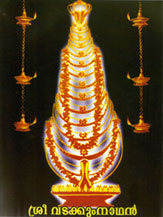
Vadakumnathan is one of the 108 Sivalayas consecrated by Saint Parasurama. Since Devi Parvathy was alongside Siva when he gave darsan to the saint, Parvathy was also installed facing east in the temple. Lord Vigneswara and Lord Sreerama were also added to complete the installation.
The mode of dharsan for this temple was formatted by the saint Adi Sankara, who in turn was a born to his parents for their Tapsya at this temple. This dharsan order is still followed without alternations.
Arjuna's Villkuzhi: During the Mahabharata war Jayadra was killed by Arjuna to retaliate his son Abhimanyu's heroic death trapped in "chakra view-ha". Jayadra was an ardent devotee of Lord Siva and hence the arrow that killed him fell in to the Vadakumnathan temple courtyard. As per Sree Krishna's advice, Arjuna prayed to lord Siva and was condoned of his sin for killing Jayadra. A deep well was formed where the arrow fell and legend says that Arjuna cleaned his arrow with the water from this well. It is customary to wash your feet with water from this well before starting dharsan in this temple. Few meters away from this villkuzhi, towards north there are two granite pillars. Samorin of Calicut paid an offering "gold thulabharam" to Vadakumnathan .To perform this offering (articles weighed against one's own weight) this giant pillars were made.
Gosalakrishna: Saint Villuamangalam who has having a close rapport with all deities, once noticed a hallo on the northern side of the temple, which then slowly turned into a cowherd and cows. The saint felt the presence of lord Krishna and as per Villuamangalam direction the Gosalakrishna temple was built.
The Hrishba temple: is located on north-west side of the northern entrance. Carved out of fine granite stone the idol is a bullock in sleeping posture. Earlier, the bullock was in standing position and was worshipped from the front side (east). One morning the idol was found lying and later front door was closed and instead side view was opened. Since the idol is a sleeping deity, the Hrishaba should be worshipped after waking him up by clapping your hands. A piece of thread from your dhoti is to be presented as an offering to the God to cover up his nakedness. There is a school of thought that the idol is of "Digambra" of Jainisam. After completing his duties Saint Parasurama disappeared at the north east corner of the temple (eesana cone - north-east corner), where you will see a small area earmarked with walls and lightened with a lamp. The kings, the arch enemies of the saint, used avoid this holy place hence the nearby bypass.
Simhodara Temple: Next to the eastern pathway connecting the east gopuram lies "Simhodara" temple. Simhodara is the trusted lieutenant of lord Siva and is guarding the main Siva temple, by watching the "thazikakudom" (There is a hole - triangle in shape - in the main wall, through which you can have the dharsan of the temple's "Thazhikakudam"). The real name of this deity is "Sarvaka" who was a student of wrestling to Nandikeswara (the holy bullock). During the trail the central part of the body of sarvaka was elongated and the name simhodara (belly of lion). Lord Siva agreed to be in Kerala as per the request of saint Parasurama and Sarvaka was deputed to find a suitable place. Sarvaka travelled all over and found all are suitable places. He was tired from the journey and was taking rest when Lord Siva came along with Devi. He kicked Sarvaka to the present place (kadikuzhi- the drainage).
An ardent devotee of Vadakumnathan used to pray for a humble request to have dharsan of Kasi Viswanatha. As per the recommendations from Sree Parvathy, lord made a direct tunnel to Kasi and invited the devotee to travel along with. The moment they touched Kasi, Sree Parvathy requested Simhodara to close the tunnel (you will see a balikallu here to mark the spot). It is believed Sree Parvathy had a second thought that Ganga may use this tunnel. The devotees are advised to put a stone as a helping hand to the closure. However this practice was banned as per a devaprasana, recently.
Sambuthara: This is the platform at south east corner where you salute Lord Chidhambara by facing east and Lord Rameshwara by facing south. Lord Siva used to dance as "Nadaraja" (King of Dance) in Chidambaram which is reflected in Rameswaram as well. As per Nandikeswara's (the holy bullock) advice, Anantha, the 1001 headed Serpent king watched the shadow - sitting on this platform - of this dance and was blessed to notice the same at the entrance of the sanctum sanatorium of Vadakunnathan temple as "Nirtha Nathan".
Amma thara: Here we salute "Oorakathamma" and "Sree Koodalmanikyaswamy (Sree Bharatha)". A part of the holy spirit of Sreekamakshi accompanied the ardent devotee Thiruvalayannur Bhattathiri (Poomulli Namboothiri) to stay near Sree Parvathy at Vadakunnathan premises. Yielding to the prayers of Bhattathiri, Kamakshi was allowed to settle at Oorakam, which is located at around 10 KM southwards, as Oorkathamma. Similarly the idol of lord Bharatha was to be installed adjacent to Sreerama temple. But as per the humble prayers of Vakayil Kaimal the idol was installed at Irinjalakuda, 20 km southwards of Vadakunnathan. It is believed that every day both Sreevparvathy and Sreerama pay a visit to this Ammathara to see their sister & brother respectively.
Kali sila: Kali sila, the small stone kept within the walls of the temple, is gradually growing in terms of height and when it reaches the height of the western gopuram, the Kaliyugam ends. To prevent this devotees throw the balance of the Sivaprasad on it.
On "Thrikarthika" day, Sri Villuamangalam found Lord Siva sitting on the compound wall adjacent to the southern gopuram. The almighty was enjoying "Karthika vilakku" of Kumaranellor. Till then one pooja to lord Siva is done here on Karthika day.
Main shrine: While entering the main shrine, just behind the Nandi and on the northern wall is a rare mural painting. It is "Vasuki sayana". Vasuki is the serpent king and the garland of lord Siva. Here lord Siva is lying on Vasuki (as Lord Vishnu on Anantha).
Lord Sankaranarayana is also called Madhyanathan (Lord of center - may be because it is in the center of Rama & Siva temple). As per the rule we have to pay dharsan 4 times to both Siva and Rama temple. But to Sankaranarayana it is 6 times. There is no practice to give any type of prasadam from this shrine.
However Lord Sankaranarayana is the custodian of all movable and immovable assets of Vadakunnathan temple.
Temple: The newly wed couples - Sree Rama & Seetha - was blocked on their way to Ayodhya from Midhila by Parasurama. Sree Rama defeated Parasurama and the saint donated all his powers to Sree Rama. Sreerama was travelling by the chariot given by lord Sun, so devotees pay respect to soorya (sun) at the south side of the temple. Devotees pay respect to Nrsimha portrait on the wall.
Ganapathy Temple (Venmadakoil): Vadakkumnathan had 12 day utsavam during "Uthrayana" season and discontinued due to various reasons. Once the coffer was empty and the "Yogadirippad" had an oracle to remove the Ganapathy idol. A dark room (nilavara) was found below the peetam and a golden lizard lightening the whole place. The room was full of gold and jewels. The chieftain took only whatever needed to conduct utlsavam. You will see a stone carving of the lizard to commemorate this.(behind the left door to the main entrance of the Valiyambalam). Touch and pray for the prosperity here. There is a mural painting near the sopanam of the Lord Siva temple. It is the "sundra yakshi" (Beautiful apsara). If you touch and pray on this portrait, this charming young lady will marry you.
Northern Gopuram: On close observation you may find that the Northern gopuram of Vadakumnathan Temple is slightly leaning. There is a legend behind this too. Once upon a time, a small golden serpent was found in a bell of the Namaskaramandapa of Vadakumnathan and Karrat Namboodhiri tried to pull it down to win a bet. The tail of the serpent started growing beyond the temple pushing away the Namboodhiri. Finally Karrat found asylum in the pond (kokarni - near to north gopuram). Chasing serpent covered the pond and the Namboodhiri had no choice but to beg for help from "Garuda". When Garuda came and took position on the northern gopuram, the serpent (who was actually Vasuki) vanished. The gopuram could not carry Garuda's weight and started to lean and the king of birds flew away.
Eastern Gopuram: The chief priest of Vadakumnathan used to do some secret pooja after daily routine in a room in this gopuram. It is rumored to be black magic and as per Maharaja's order an employee peeped through a hole in the door to verify this. It was just "Bhagavathy Seva" and during the climax of the pooja, employee saw an amazing power source, which as per the legend blinded him. The room remained closed for decades.
Southern Gopuram: Southern Gopuram is a donation from King of Kodugallore and hence devotees pay their salute to Kodugallore Devi here. To pass through this gopuram is said to be a journey of no return. In olden days, the convicts, who were sentenced to death, were brought to Sankaranarayana Temple for their last rites. They were made to wear red garlands and would later be handed over to "Arachar" waiting outside the southern gopuram. The sentence was performed at a place called Anchery, some 6km south east of Vadakumnathan. However the doors of this gopuram are now opened only for Thrissur pooram. "Neithilkavilamma" a participant pooram deity opens this door from outside on the day before pooram and will be closed the Thrissur pooram day after the royal dharbhar "Thekkottirakkam".
Western Gopuram: The western gopuram was constructed by the Perumppadappu Swaroopam of Cochin dynasty. The "deepasthambham" was donated by Samoothiri of Calicut as a token of compromise between Perumppadappu and Calicut.
